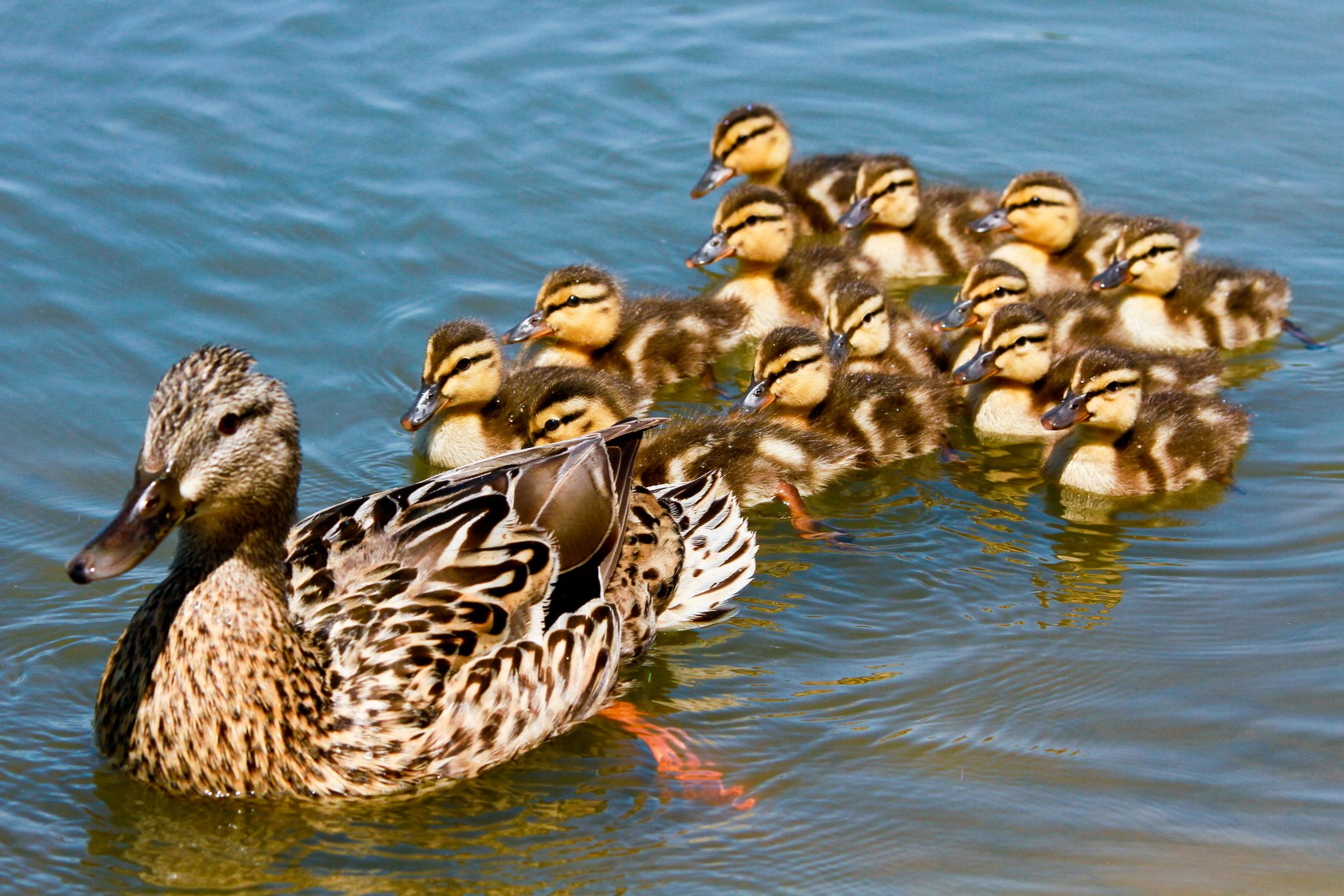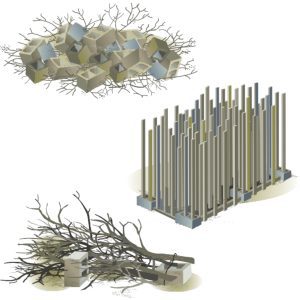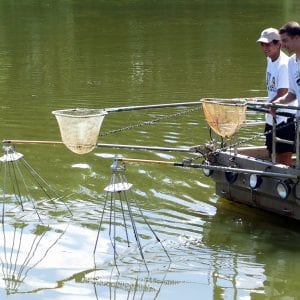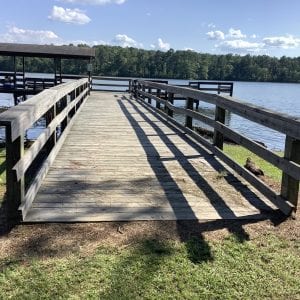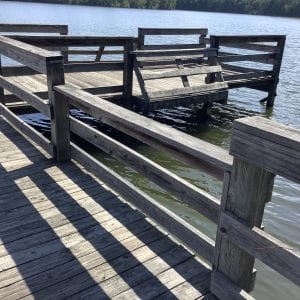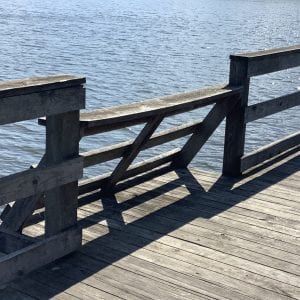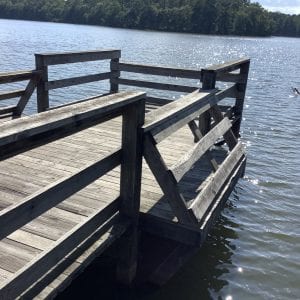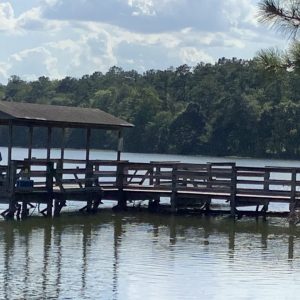Fish & Water

This is an excerpt from “Pond Building: A Guide to Planning, Constructing & Maintaining Recreational Ponds,” ANR-1114. Find all sections of the publication at www.aces.edu.
Dam and Spillway Maintenance
Once a pond is completed, the dam and spillways require some maintenance. Vegetation on the dam must be mowed and occasionally fertilized. Trees should not be allowed to grow on the dam or in the emergency spillway. Any erosion or scour in the emergency spillway should be immediately repaired and revegetated. Debris in the trash rack should be periodically removed. The spillway pipes should be inspected and the valve checked annually for proper operation.
Controlling Vegetation on Pond Banks and Dams
Pond bank vegetation should not be allowed to grow uncontrolled. Vegetation such as cattails, willows, reeds, and sedges are acceptable in limited areas and amounts if desired, but excessive shoreline vegetation will limit access to pond banks and hinder fishing, swimming, and other activities. Thick vegetation on banks also provides habitat for muskrats and beavers, which can cause severe damage to ponds (see Muskrat and Beaver Control).
Woody vegetation should not be allowed to grow on dams. Tree roots can eventually penetrate the core of the dam and cause excessive pond seepage. Trees that have been allowed to grow on older dams should be cut down if they are less than 8 inches in diameter at chest height. Larger trees should be left in place unless the owner or contractor has the equipment and expertise to remove the root ball of a large tree. Large diseased or dying trees on the dam should be removed by a qualified contractor or arborist who will remove the root ball and fill the void with compacted clay. If a large tree on a dam blows over during a storm, the tearing out of the roots could compromise the dam.
Muskrat and Beaver Control
Muskrats and beavers are burrowing animals that can cause extensive damage to pond structures. Their burrowing activities damage ponds by weakening and eventually caving in pond banks and dams. Beavers also can stop up pipe spillways and build dams across emergency side spillways and diversion ditches. Beavers can damage valuable timber as well. Keeping pond banks neatly mowed and trimmed will help discourage muskrats and beavers by removing desirable habitat. However, many ponds have chronic problems with these animals. Trapping or shooting (where safe) are the usual means of removing muskrats and beavers. Muskrats can be trapped during the season or at other times by special permission from a local conservation office of the Alabama Department of Conservation and Natural Resources. There is no closed season on beaver in Alabama. For more information see “Beaver Control in Alabama” (Extension publication ANR-0630).
Deepening Pond Edges
Proper pond design and construction are the first and most important steps in preventing aquatic weed problems. Shallow water areas are more likely to develop aquatic weed infestations. Pond edges should quickly slope off (2:1 to 3:1), reaching 3 feet of depth. Ponds should be designed and constructed so that there is no more than 20 percent of the pond 2 feet in depth or less. Shallow narrow areas between pools or an island and the bank can create areas for excessive weed growth. Deepening these areas can help prevent this problem.
Ideally, pond edges should be deepened during the initial construction phase. However, it is possible to correct existing ponds with shallow edges by lowering the pond level in mid-September (after fish spawning) and allowing the edges to dry enough to permit machinery into the pond area. Three methods of pond edge deepening are illustrated in figures 18, 19, 20, and 21.
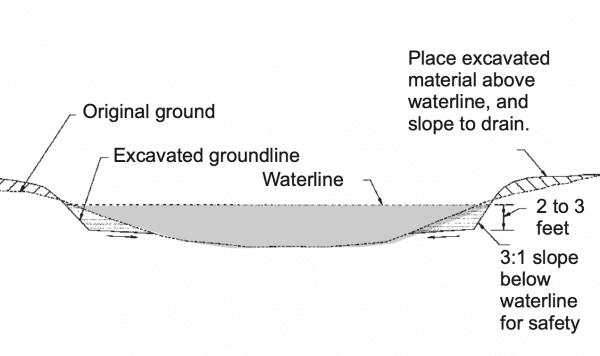
Figure 18. Method 1: Dig edges deeper and place soil on outside edge of pond (not to scale).
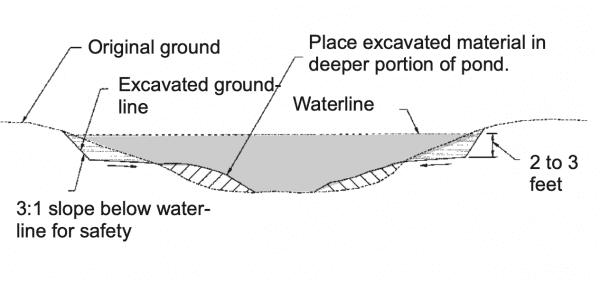
Figure 19. Method 2: Dig edges deeper and place soil in deeper portions of pond (not to scale).
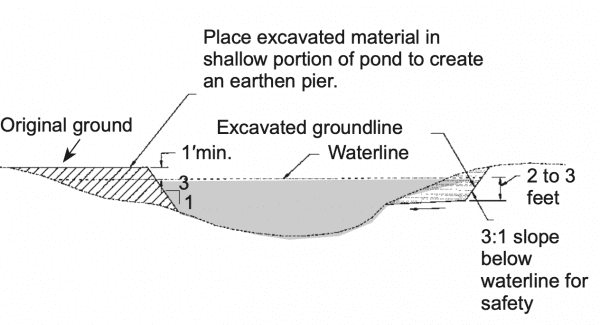
Figure 20. Method 3: Dig edges deeper and use soil to make earthen fishing piers (not to scale).
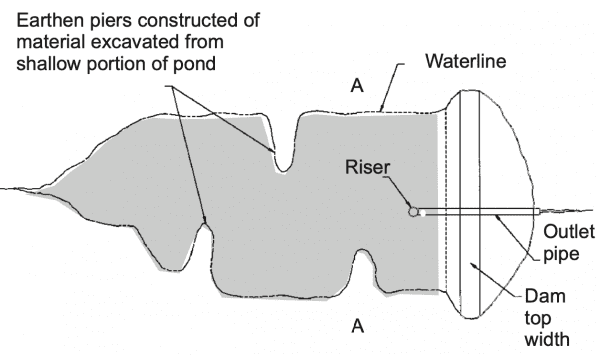
Figure 21. Method 3: Plan view of pond with earthen piers (not to scale).
Leaky Ponds
Excessive seepage is a common pond problem in many areas. Most severe seepage problems can be traced back to two fundamental causes: a poor site and/ or improper pond construction practices. A poor site may be one in which either the soils are too permeable to hold water and/or the underlying geology is not conducive to holding water. Risky geological structure includes underlying cavernous limestone prone to develop sinkholes or exposed rock areas in the pond bottom around which water might channel beneath the pond. Seepage rates can vary considerably for ponds, depending on the dominant soil type. However, properly constructed ponds on good sites will have low seepage rates. Table 1 lists relative seepage rates plus average summertime evaporation in the Southeast to show typical water level drop (assuming no added water from rainfall, runoff, groundwater, or other sources).
Table 1. Seepage Rates Showing Potential Summer Water Level Drop
*Evaporation averages about 1 inch per week (June–September).
**Assuming no water entering pond
Units shown in inches per week
| Seepage Rate | + Evaporation* | = Pond Water Level Drop** | |
|---|---|---|---|
| Low | < 1.4 | + 1.0 | = < 2.4 |
| Medium | 1.4 to 2.75 | + 1.0 | = 2.4 to 3.75 |
| High | > 2.75 | + 1.0 | = > 3.75 |
Ponds that leak excessively can be difficult and expensive to fix after the pond is constructed. However, because of water needs, ignorance, or other reasons, ponds are often built on marginal sites and under less- than-ideal conditions. When excessive seepage occurs, there are several methods to attempt to reduce seepage to a tolerable level.
Improper pond construction techniques are often the cause of excessive seepage. As discussed previously under Pond Construction, most embankment ponds require a cutoff and core trench compacted with a good- quality clayey material along the centerline of the dam and extending down into impervious material. Failure to properly install the core trench can result in excessive seepage through the base of the dam. This problem can sometimes be corrected through draining the pond and installing a new core trench in front of the dam.
Proper soil moisture is very important for obtaining optimum compaction during the construction phase. Ponds constructed with soil either too dry or too wet can result in excess seepage due to poor compaction. Generally, the soil is too dry if it can’t be molded in your hand and too wet if it adheres to the construction equipment or is obviously saturated. There are several methods and materials that can be used to seal leaking ponds, including compaction, clay blankets, bentonite, chemical dispersing agents, and pond liners.
COMPACTION
Sealing by compaction is one of the least expensive sealing methods. This method can work on pond sites containing soils of a wide range of particle sizes and some clay (at least 10 percent) and silt to make a seal. The procedure involves clearing the pond area of all trees and stumps and filling any remaining holes with good-quality clayey soil. The top 8 to 10 inches of soil should be disked and then all rocks and tree roots removed. The soil is then compacted under proper moisture conditions with four to six passes of a sheepsfoot roller (see figure 15). The compacted layer should be no less than 8 inches thick for water depths of 10 feet or less. In areas where the water will exceed 10 feet in depth, compact two or more layers, not exceeding a thickness of 8 inches per layer.
CLAY BLANKETS
If the clay content of the soil in the pond area is not sufficient to make a good seal, laying down a clay blanket may be an option worth considering. Ideally, good-quality material containing at least 20 percent clay should be obtained from a borrow area near the pond site to minimize hauling costs.
Preparing the pond area for a clay blanket is the same as preparing the area for the compaction method. The material should be spread in layers 6 to 8 inches thick and compacted as previously described. A blanket thickness of 12 inches is sufficient for water up to 10 feet deep. Add 2 inches of thickness for each foot of water over 10 feet. Clay blankets should be protected from cracking due to drying or freezing and thawing.
Protection can be provided by spreading a 12-to-18-inch cover of gravel between the anticipated high and low water levels of the pond. The quantity of soil needed to form a clay blanket can be substantial. A 1-foot-thick blanket spread over 1 acre requires more than 1,600 cubic yards of clay.
BENTONITE
Bentonite is a type of fine-grained clay that absorbs water and swells from 8 to 20 times its original volume and is available either as sodium or calcium bentonite. Sodium bentonite swells to a much greater extent than calcium bentonite and therefore should be the form used to seal ponds. Before spreading bentonite, prepare the pond area the same as for the compaction method.
When used as a pond sealer in a dry pond, bentonite is mixed into the top 6 inches of soil and then compacted and saturated. When saturated, the bentonite particles expand to fill the pores between the soil particles. Soil moisture in the treatment area should be near optimum for good compaction. If the area is too wet, postpone treatment until conditions improve. If the area is too dry, sprinkle water over the area to moisten it.
Bentonite also can be added to the pond water over the suspected area of the leak, but it is not as effective when applied in this manner. The granular form is more effective than the powder form because the granules, when sprinkled on the pond surface, tend to sink to the bottom before becoming saturated with water.
Application rates for bentonite range from 1 to 3 pounds per square foot, depending on the soil type. Bentonite will shrink and crack when dry and is not recommended for ponds in which the water level fluctuates widely through draining or excessive evaporation. Before filling the pond with water, protect treated pond areas from drying by mulching with hay during the final compaction stage.
Bentonite can be expensive to use, and, as with any pond-sealing method, there are no guarantees that it will stop the leak. With most ponds, whole-pond treatments are not practical. Treatment efforts should be concentrated around the suspected problem areas.
CHEMICAL DISPERSING AGENTS
Some fine-grained clay soils will seep excessively because the clay particles are arranged in an open honeycomb structure. Certain chemicals, known as dispersing agents, can have the effect of rearranging the clay particles, causing the open structure to collapse. Treatments with dispersing agents are effective only in soils containing more than 50 percent of fine-grained material (silt and clay finer than 0.074 millimeters in diameter) and at least 15 percent of clay finer than 0.002 millimeters in diameter. Chemical treatment is not effective in coarse-grained soils.
The most commonly used dispersing agents are sodium polyphosphates, including tetrasodium pyrophosphate (TSPP) and sodium tripolyphosphate (STPP). The dispersants should be finely ground particles. Application rates range from 0.05 to 0.10 pound per square foot. Sodium chloride, which is less effective, is applied at a rate of 0.20 to 0.33 pound per square foot. Soda ash is another chemical that is sometimes used as a dispersing agent at 0.10 to 0.20 pound per square foot. A laboratory analysis is recommended to determine the most effective type and rate of dispersing agent to use.
POND LINERS
The use of flexible membranes, such as high-density polyethylene, vinyl, or butyl rubber, is an effective but costly way to reduce excessive seepage losses in recreational ponds. Pond liners such as those used in landfills, lagoon ponds, and other industrial applications are generally impractical for all but the smallest of ponds or ornamental pools because of the cost of the liner material and installation.
ENHANCEMENTS
There are a number of things pond owners can do to enhance the usefulness and productivity of their ponds, particularly for fishing and to attract wildlife.
FISH ATTRACTORS
Fish attractors help anglers locate and catch fish. These structures attract fish by providing them cover and serving as habitat for aquatic insects and forage fish upon which the sportfish feed. Common types of fish attractors include evergreen treetops weighted or anchored to the bottom, piles of rocks or cinder blocks, and tied and weighted reefs of discarded tires. The attractors should be placed at relatively shallow depths of 2 to 6 feet where oxygen levels are adequate.
In newly constructed ponds, windrows of trees cleared from the site can be positioned as fish attractors. In ponds fished by boat, fish attractors should be submerged enough so that they don’t interfere with boat movement.
The number of fish attractors should not be too numerous because too many will defeat the purpose of trying to concentrate fish where anglers can more easily find them. One to three fish attractors per acre are sufficient. The primary reason to add structure to a pond is to concentrate the fish, making them easier to catch. If the fish are easier to catch, anglers should gain greater enjoyment from the pond, be able to better harvest the amount needed for proper management, and experience improved assessment with electrofishers. Brush and other structures also can improve the survival and sustainability of some kinds of forage, such as bream and certain minnows.
- Figure 22. Fish attractors serve as habitat for aquatic insects and forage.
- Figure 23. Electrofishing can help improve pond assessment.
FERTILIZER PLATFORM
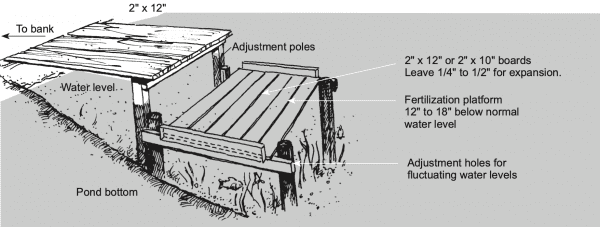
Figure 24. A fertilizer platform can be used to suspend fertilizer.
Ponds managed for bass and bluegill fish are often fertilized to increase fish production and help control aquatic weeds. See “Management of Recreational Fish Ponds in Alabama” (Extension publication ANR-0577). If a granular form of fertilizer is used, the fertilizer should be suspended away from the pond bottom in 12 to 18 inches of water. One method of suspending the fertilizer is the use of a fertilizer platform (figure 24). The platform should be 3 to 4 square feet. Ideally, one platform should be installed for every 5 to 10 acres of pond.
FISH SPAWNING BEDS
Fishing for bluegill (bream) during the spring or summer spawn is a favorite activity of many anglers. Shoreline areas can be enhanced to encourage the bluegill to spawn in a particular location where anglers can easily locate them and where fishing access is best. Small gravel (pea gravel) is a preferred substrate for bluegill spawning beds and can be spread in an area of the pond where anglers would like to fish. Spread the pea gravel in a 4-to-6-inch layer in 2 to 6 feet of water. The gravel can be contained within a wooden frame if the area is particularly silty.
WILDLIFE
Ponds naturally attract wildlife and can be managed to encourage visits from particular types of animals. Nesting boxes for wood ducks can be placed over the pond. Shoreline vegetation, such as cattails, rushes, and smartweeds, attract many types of wildlife, including water birds, shorebirds, songbirds, rabbits, turtles, frogs, and snakes. Shoreline vegetation, though potentially undesirable in excessive amounts, can be allowed to grow in limited areas as long as the pond owner is willing to control its coverage. If shoreline vegetation is allowed to grow, the trade-off is that excessive pond bank vegetation limits fishing access and may attract nuisance wildlife, such as muskrats and beavers. Planting food plots and mast-producing trees (although not on the dam!) will attract wildlife with food and water. Incorporating legumes such as clover in the ground cover and wildflowers in areas that won’t be mowed, will attract and support pollinators such as honeybees.
Accessibility
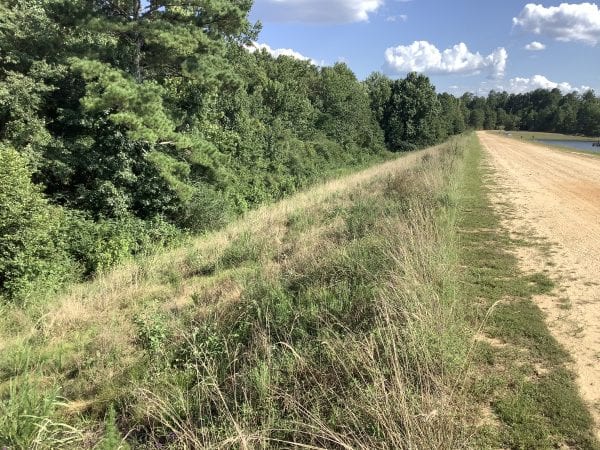
Figure 25. A well-maintained dam with no trees and a roadway along the bank provide convenient access to the pond.
A well-designed and maintained recreational fishing pond can be accessible to individuals with a wide range of mobility and physical abilities. By considering accessibility and incorporating a few elements of construction and maintenance, your pond can provide enjoyment easily and safely to everyone.
Road access to a pond is important for convenience and maintenance (figure 25). Having a road to the pond and preferably around the entire shoreline allows access for large equipment needed for construction or to bring in lime and mowing equipment. A gravel boat ramp with a consistent slope allows fishing boats, lime barges, and electrofishing boats (if necessary for assessment) access to the pond. Road access also provides a way for individuals with limited mobility to be transported close to the pond.
Construct wide trails with gentle slopes, even and firm surface material, and handrails in steep sections. Trails free of tripping hazards are safer for everyone.
To make fishing piers accessible and safe, start by grading the access trail up to the pier, making it reachable without having to step up onto the decking.
Make the pier wide enough so that anglers can easily pass others who are seated and fishing. Create sections of the pier that are lower (34 inches) for seated anglers and children (figure 27). Lowered railings with extensions for wheelchairs also can be added (figure 28). Providing shade over a portion of the pier or along the shoreline provides refuge from the summer sun (figure 29).
Lockable storage at the pond allows extra fishing chairs, fishing equipment, and chemicals, such as fertilizers, to be readily available. Having these supplies stored at the pond helps facilitate maintenance and allows for some impromptu fishing when you stop by the pond and the fish are active.
For more information on pond and fishing structure features and designs compliant with the Americans with Disabilities Act, visit www.ada.gov to obtain the latest version of the ADA Standards for Accessible Design Guide.
- Figure 26. Accessible pier entrance
- Figure 27. A low railing is convenient for seated anglers and children.
- Figure 28 a. Lower railings with extensions are convenient for wheelchair access.
- Figure 28 b. Lower railings with extensions are convenient for wheelchair access.
- Figure 29. A shaded area on a fishing pier provides relief from the summer sun.
 Revised by Russell Wright, Extension Fisheries Specialist, School of Fisheries, Aquaculture, and Aquatic Sciences, Auburn University. Written by Chris Hyde, Extension Aquaculturist, Department of Fisheries and Allied Aquacultures, Auburn University, and Perry Oakes, State Conservation Engineer, USDA Natural Resources Conservation Service, Alabama. Adapted from “Ponds–Planning, Design, Construction,” USDA NRCS. 2000. Agricultural Handbook Number 590.Washington, D.C.
Revised by Russell Wright, Extension Fisheries Specialist, School of Fisheries, Aquaculture, and Aquatic Sciences, Auburn University. Written by Chris Hyde, Extension Aquaculturist, Department of Fisheries and Allied Aquacultures, Auburn University, and Perry Oakes, State Conservation Engineer, USDA Natural Resources Conservation Service, Alabama. Adapted from “Ponds–Planning, Design, Construction,” USDA NRCS. 2000. Agricultural Handbook Number 590.Washington, D.C.
Revised August 2023, Pond Building: A Guide to Planning, Constructing & Maintaining Recreational Ponds, ANR-1114

